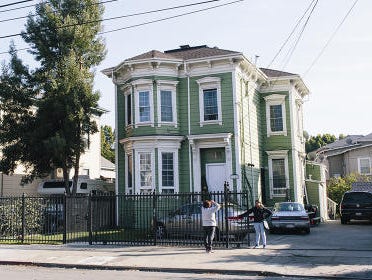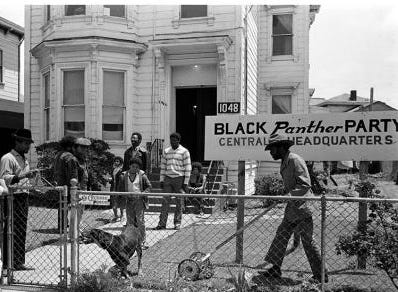Before WeWork, We Had Clubhouses
What old-school clubhouses can teach us about community in a tech-driven world
A throwaway line at the end of Join or Die hit me harder than anything from Pete Buttigieg, Raj Chetty, or Hillary Clinton: “If we want more clubs, we’re going to need more clubhouses.”
If you haven’t seen Join or Die, it’s available on Netflix. It explores the rise and fall of civic clubs in America—and what their decline has meant for democracy. But I think it’s best experienced in a group. Next week, Bay Area folks have two chances to watch Join or Die in community with others:
📅 Friday, I’m hosting a screening at Two Pitchers Brewing / Lovely’s in Oakland. RSVP here.
📅 Monday, as part of “SF Joiners1 Week” Build IRL and SF Commons2 are hosting a screening at their space.
Since watching the film, I’ve been on a mission to understand demand for physical clubhouses as part of refining the JOINERS thesis, but I hadn’t taken the time to think about what they are and why they matter.
Some of the clubhouses I’ve known:
Saint Gabriel Catholic Church basement (Cub Scouts): Not quite a clubhouse, but our shared space with other groups taught me how even temporary spaces can create belonging.
Takoma Park Pool, pre-renovation (TPDC swim team): My first experience with "home turf"—a public pool where our nearly all-Black team hosted and beat suburban, all-white teams on a weekly basis after Whitney Houston’s national anthem3 played from the PA system.
Boys and Girls Club4 of Silver Spring: Where I first played organized soccer, briefly played basketball, and learned to play pool (poorly).
B-CC High School senior’s lounge: A club more defined by exclusion than excitement. Mostly I just remember blasting Outkast’s “B.O.B.” during lunch.
REDACTED in Boston (you know the one 😉): They’ve got “clubhouses” in every city. There’s even one up by my dry cleaner in Rockridge. I was in awe—ceremonial chambers, blindfolds, fraternity, and, yes, diversity.
Being in Oakland, I can’t talk about clubhouses working on civic issues without mentioning the Black Panther Party. About a 5-minute walk from Kilovolt Coffee’s current location is the site of the Black Panther Party Headquarters.
In addition to hosting the newspaper staff, Peralta Street is also where national decision-making lived. Although they inspired the movement as far as my mother’s college campus at Howard University, The Black Panthers5 were not a social club. They were, however, definitively a civic club because their work was grounded in the betterment, protection, and support of their community.

Recently, I’ve learned about a neighborhood clubhouse culture in Berkeley/Oakland. A friend from high school (who also hung in the senior lounge, I think) lives in the next neighborhood over. She and her husband recently got involved in a social club right in the midst of their neighborhood.
The Claremont Club6 was founded in 1911, at the height of the Progressive Era’s club-joining boom, by neighborhood women. While primarily a social club, it was through the social that this community’s bonds strengthened (often to the exclusion of others).
Slightly more than a decade earlier, the Hillside Club of Berkeley began as an effort “to preserve the natural beauty of the Berkeley hills” in accord with the Arts and Crafts movement’s push for coexistence with nature. I find this clubhouse example motivating7 because of the synthesis of the physical design (architecture and materials), social engagements (philosophical salons), and the political (urban planning recommendations8).
But perhaps the clearest historical precedent for JOINERS has local precedent in the Women’s City Club of Berkeley. From the Berkeley, California Year Book of 1930:
In April 1927, a group of Berkeley women, long having felt the need of a center for women’s activities and long having cherished the plan of bringing this into being in their city, called a meeting of delegates from various women’s clubs in Berkeley. A temporary chairwoman, Dr. Kate Gompertz, was authorized to appoint committees to complete the organization of a Women’s City Club for Berkeley.
The organizers held a membership drive such that, by the Julia Morgan9-designed building’s opening, there were 4,000 members.
The City Club even offered “four types of membership: Life, Regular, Non-resident and Junior, all with modest initiation fees and dues,” according to the Year Book. This is in stark contrast to our current clubhouse culture that’s crept towards commodification and inaccessibility.

The Women’s City Club aimed to “contribute to social, civic, and cultural progress”—not by replacing existing clubs10, but by giving them infrastructure and a home base. It even offered “club rooms for rent to unhoused clubs.” And amenities like a pool, private courtyard, and dining hall. In other words: social infrastructure. Sound familiar?
These examples are by no means perfect, but it’s worth noting that they all came about during times of incredible turmoil, inequality, and tyranny in our country — whether in the Gilded Age or the turbulent 1960s. Sound familiar?
I’m no scholar of clubs, but I wouldn’t say they solved any of these challenges, especially given what we’re experiencing today. But they gave more people a way to get in the fight—even if they came from exclusionary, imperfect origins.
The question isn’t just whether we can do this again—it’s whether we can do it better. More inclusively. More joyfully. And whether we can build clubhouses that don’t just reflect community, but actively help people join one.
That’s what JOINERS is working toward. And with the current state of the world, the question is: who will help us build?
Upcoming Events:
April 19, 2pm ET. Find common ground - Addressing Immigration. Braver Angels will bring together an equal number of Reds and Blues to do a deep dive into the topic of immigration. By the end, participants will jointly come up with shared points of agreement, values, concerns, and policies. Sign up free on Eventbrite.
April 24. Workshop with Roopa Mahadevan (JOINERS regular) to advance your performing skills and improvisation using Carnatic concepts. Open to active musicians of any genre and/or those with some Carnatic training (around 5 years, e.g., geetham/swarajathi level). Limited to 15 participants. Group and individual coaching. RSVP at Wyldflowr.
April 25, 5-9pm: JOIN or DIE Screening. Join or Die is a film about why you should join a club—and why the fate of America depends on it. Follow the story of America's civic unraveling through the journey of Robert Putnam, whose legendary "Bowling Alone" research into American community decline may hold the answers to our democracy's present crisis. RSVP on Partiful.
April 25. Roopa Mahadevan Carnatic concert, featuring violin and mridangam accompaniment. RSVP at Wyldflowr.
April 26. Roopa Mahadevan’s crossover concert, featuring Indian classical with jazz, R&B/soul, free improv arrangements. RSVP at Wyldflowr.
May 4, 9:30-12pm: Make a Miniature Vignette. In this 2.5 hour workshop for adults, you’ll create a miniature scene that features a wall and floor, framed piece of art, console table, miniature books, and clock. You’ll get to customize your space with a choice of art print and mini-framing method, “tile” color and pattern, wall color, clock color, and more. Final dimensions approx. 7.75” tall x 6” wide x 3.7” deep. Hosted by JOINERS regular, Erica Meade. RSVP at Brushstrokes Studio.
No relation.
SF Commons is a clubhouse example like we’ll discuss in this issue.
Is there any other?
The Boys and Girls Clubs of America’s (federated nationally in 1906) sites across the country are called clubhouses, and offer an example of progressive era “clubbing” we’ll come back to.
It’s worth noting, given the role of women in the rest of this issue, that the majority of Black Panther Members by the early-1970 were women.
Notably designed by Charles Sumner Kaiser.
Despite the implicit NIMBYism!
You may credit them for the curvy and disorganized streets of the Berkeley Hills because they were opposed to gridded streets.
California’s first licensed woman architect
e.g., PTA, literary societies, professional women’s associations.







I’m that husband!